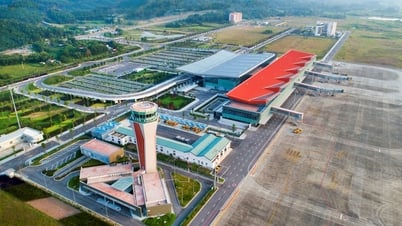In 2023, Vietnam will rank 7th in shipbuilding capacity in the world , surpassing even the "big" and famous shipbuilders like Finland. However, the export market share of Vietnam's shipbuilding industry is still limited.
The rise of the shipbuilding industry and Vietnam's competitive advantage
In 2023, Vietnam will rank 7th in the world in terms of shipbuilding capacity, surpassing even the "big" and famous shipbuilders like Finland. However, the export market share of Vietnam's shipbuilding industry is still limited.
According to Dr. Pham Hoai Chung, Chairman of the Board of Members of the Shipbuilding Industry Corporation - SBIC, the world's shipbuilding industry is shifting. Accordingly, the dominance of China, Korea, and Japan (especially with commercial ships).
In addition, there are many factors affecting the Vietnamese shipbuilding industry such as the international maritime organization's carbon emission reduction strategy, Vietnam's efforts to achieve zero net emissions; conflicts in Russia - Ukraine, the Middle East... affecting the shipbuilding industry.
Currently, the demand for maritime transport is increasing due to changes in shipping routes, requiring larger ships that can cope with harsher environments.
As of June 30, 2024, Vietnam has 88 shipbuilding enterprises and 411 inland waterway vehicle construction facilities (of which about 120 enterprises build and repair ships with a tonnage of over 1,000 tons).
Vietnam's shipbuilding industry possesses a shipbuilding system stretching from North to South, with diverse production capacity.
However, according to Mr. Chung, there are still many limitations compared to countries with strongly developed shipbuilding industries, especially in terms of technology, production capacity and competitiveness.
Shipbuilding products are increasingly diverse and of high quality, meeting the needs of domestic and international markets. Vietnamese shipbuilding enterprises have succeeded in building new types of large-capacity ships, specialized ships, high-speed ships, high-tech ships, etc. Some enterprises have affirmed the position of the Vietnamese shipbuilding industry in the world market.
In addition to the domestic shipbuilding market, businesses have participated and integrated with the international market. However, the export market share of the Vietnamese shipbuilding industry is still limited.
In 2022, Vietnam will rank 6th in shipbuilding capacity in the world, after China, South Korea, Japan, Taiwan, and the Philippines.
In 2023, Vietnam ranked 7th, surpassing even the "big" and famous shipbuilder Finland (0.36%, 8th place).
With the development of global trade, Vietnam's maritime transport demand is also forecast to grow strongly by about 10% per year in the period 2023 - 2030. The total demand for new construction, additions and replacements of Vietnam's maritime transport fleet from now to 2030 is forecasted to be about 4 - 5 million DWT.
By 2023, the world's maritime fleet involved in cargo transport will be approximately 105,500 ships with a capacity of 100 GT or more, with an average age of over 20 years. The average growth in the global fleet's tonnage will be 4.9% per year in the period 2011 - 2021.
In recent years, the size of the world shipbuilding market has grown strongly with the trend of more modern, larger tonnage and increasing demand for green technology conversion ships and clean fuel use.
 |
| Shipbuilding businesses need to reduce operating costs by investing in advanced technology to improve performance and reduce emissions. |
Vietnam is not only an attractive destination for many countries, but the potential for the shipbuilding market is huge.
To take advantage of the shift in the world's shipbuilding industry from Europe and North America to Asia, according to Mr. Chung, Vietnam needs to promote its existing advantages such as a rapidly developing shipbuilding industry, focusing on medium-sized commercial ships.
With global fuel costs rising by around 20% over the past year and demand for maritime cargo expected to grow by 3% per year through 2030, international shipowners are focusing on optimizing efficiency and minimizing operating costs by investing in advanced technology to improve performance and reduce emissions. To meet the growing demands of the industry.
More than 100 leading units in the world's maritime and shipbuilding industry recently attended the Vietnam Maritime and Shipbuilding Machinery and Equipment Exhibition (VIMOX) 2024. Specialized machinery and equipment, from solutions to automate production processes to systems that help save energy and protect the environment, had the opportunity to be displayed.
In particular, the Offshore Wind Power Exhibition is also present in this space, aiming to promote green technology and open up prospects between these two key areas. In which prominent names in the field from China are also present.
According to the World Bank (WB), Vietnam's offshore wind power potential is about 600 GW, and this energy source is expected to provide 12% of the country's total electricity output by 2035. As the WB analysis team said, Vietnam has attracted international attention with its renewable energy plans, but delayed policies have caused some potential investors to reconsider their plans.
China has now developed a relatively complete offshore wind power technology and industry chain, covering design, manufacturing, construction, operation and maintenance.
China's installed offshore wind capacity has increased sharply from less than 5 million kW in 2018 to 37.7 million kW in 2023, accounting for 50% of the global total. Notably, the localization rate of offshore wind turbines in China has exceeded 90%, reflecting high self-sufficiency in production.
In the future, China's offshore wind power industry will innovate its industrial integration model, strengthen research on core technologies, and promote coordinated development to form internationally competitive industrial clusters. This is also a move that Vietnamese shipbuilding enterprises will research and implement.
Source: https://baodautu.vn/su-troi-day-cua-nganh-cong-nghiep-dong-tau-va-loi-the-canh-tranh-cua-viet-nam-d231017.html
































































































Comment (0)